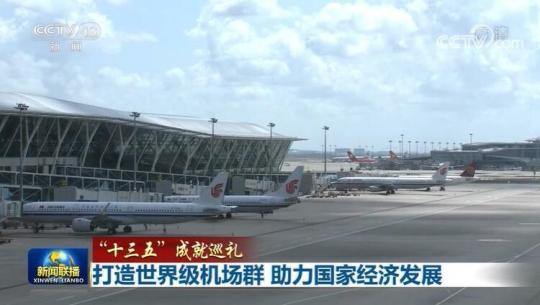["Thirteenth Five-Year" Achievement Tour] Build a world-class airport cluster to help the country's economic development
CCTV news (news broadcast): During the "13th Five-Year Plan" period, my country's civil aviation continued to increase the pace of airport construction, and strive to build four world-class airport clusters represented by Beijing-Tianjin-Hebei, realize the linkage between airport clusters and urban clusters, and serve the country. Development boost.
According to the latest data released by the Civil Aviation Administration of China, the passenger throughput of Beijing Daxing International Airport will exceed 16 million in 2020.
Since its commissioning on September 25, 2019, the passenger throughput of Daxing Airport has reached more than 19 million passengers.
During the "13th Five-Year Plan" period, Beijing Daxing International Airport completed the scheduled construction tasks in less than 5 years and was successfully put into operation.
Beijing Daxing Airport, Tianjin and Hebei Airports continue to form a joint force, radiating the three places of Beijing, Tianjin and Hebei.
The Airport Industrial Park, which relies on Daxing Airport, has also continuously increased its pace of construction. In the past year, it has rapidly established an industrial system led by life sciences and based on aviation services, forming an airport group with Daxing Airport as the core, and driving The development pattern of the Beijing-Tianjin-Hebei urban agglomeration.
While working hard to build Beijing Daxing International Airport and build a world-class airport cluster in Beijing-Tianjin-Hebei, since the 13th Five-Year Plan, China Civil Aviation has also strived to build three world-class airport clusters in the Yangtze River Delta, Guangdong-Hong Kong-Macao Greater Bay Area, and Chengdu-Chongqing. There are 10 international aviation hubs and 29 regional hubs including Beijing, Shanghai, Guangzhou, Chengdu and Xi'an.
In the Yangtze River Delta, the completion of the third-phase expansion project of Shanghai Pudong Airport has strengthened Shanghai’s radiating capacity as an international shipping center and boosted exports from neighboring cities such as Suzhou, Hangzhou, and Wuxi. Pudong Airport’s annual customs import and export value steadily accounts for four of the country’s total. Into the above.
In the Guangdong-Hong Kong-Macao Greater Bay Area, Shenzhen Airport is positioning itself as an international aviation hub, and is constantly upgrading its infrastructure and service levels. Its cargo capacity has increased by 27% compared to the end of the “12th Five-Year Plan” period, forming a parallel with Hong Kong and Guangzhou. Pattern.
At the end of 2020, Chengdu Tianfu International Airport, the largest hub airport in the central and western regions of the "13th Five-Year Plan", will conduct flight test verification. With Tianfu Airport as the core, it will drive and radiate the fourth largest airport cluster in the Chengdu-Chongqing Economic Circle. Has taken shape.
As of 2019, the number of tens of millions of airports nationwide has increased from 26 at the end of the 12th Five-Year Plan period to 39.
The scale of fixed asset investment completed by civil aviation is expected to increase by about 26% over the "Twelfth Five-Year Plan" period.
The new capacity of airports nationwide reached 400 million passengers.

